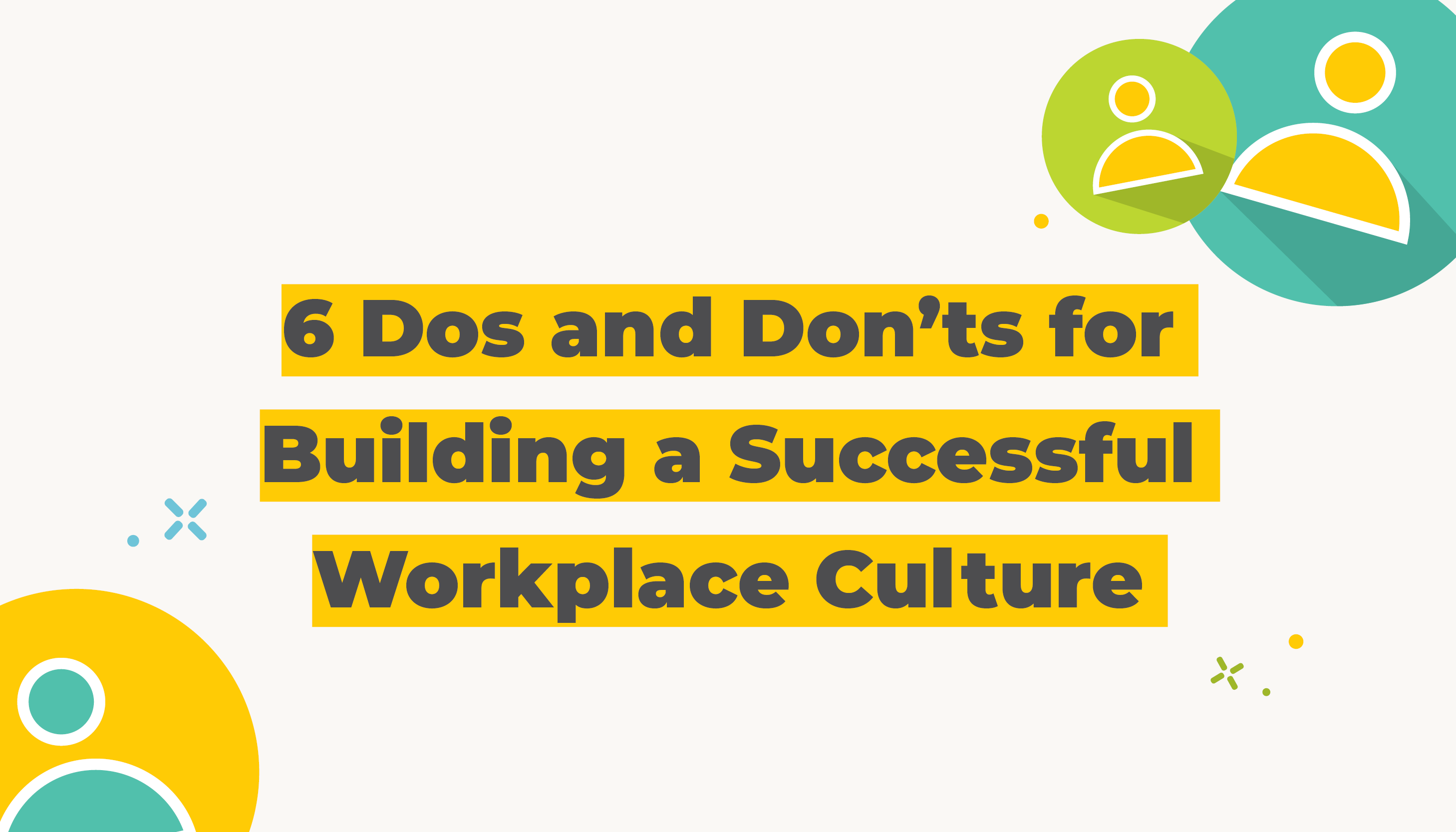6 Dos and Don’ts for Building a Successful Workplace Culture
By: Benefits by Design | Tuesday November 23, 2021
Updated : Tuesday April 25, 2023
At Benefits by Design (BBD) Inc., we’re not shy about our workplace culture — we’re proud of it. In fact, we’ve been consistently recognized for our excellent culture. But something like that isn’t built overnight, and it’s not built without learning a thing or two.
7 Employee Wellness Activities to Keep Your Company Culture Thriving
We all know that workplace culture can go a long way toward building an engaged, productive workforce. Employees that feel abandoned by their leadership tend to have lower morale and self-confidence and have a careless attitude towards work. Poor company culture can also damage your reputation as a company and can make it difficult to hire new employees.
So, here are some of the dos and don’ts to building a successful and strong workplace culture.
Don’t — Have Unclear or Absent Core Values
Core values ground a company. They’re the foundational rock from which everything a company does — and thus, its employees do — originates. Core Values must be well-known and communicated early and often, and constantly reinforced through real action. You can’t just preach your core values — you have to practice them.
In the absence of core values, employees will feel lost and confused. Employees need to feel connected to these values and see examples of them in their work and others’. The problem is that even leaders are not able to uphold values that don’t exist. Without clear direction the workplace culture can quickly turn toxic as a result, and can often be based on fear.
Do — Establish Core Values and Practice What You Preach
It is important to establish a clear understanding of the core values your company stands for right from the beginning. However, it is not enough to simply have them. They should be published internally (and externally if appropriate) and communicated consistently and often. It is also paramount that management is practicing these values and leading by example. If your managers are not embracing your core values, neither will your employees.
As an example, one of BBD’s core values is TAG — Together, Adapt, Grow. We believe that when we work together, we can adapt to new circumstances and challenges and grow, both as individuals, and as a company. This is also why our leadership team is called the “TAG team”.
One of the ways in which we make “TAG” a reality is a focus on professional development and continuous learning. Every employee has an annual professional development budget to learn a new skill, take a course in their field, and more. That’s us practicing what we preach.
Don’t — Forget About Employee Onboarding
So, you’ve found the perfect candidate and they have accepted the position. It is easy to get excited and move on to the next recruiting opportunity, but employee onboarding is a big part of the success of employee retention. In fact, a poor onboarding experience doubles the chances of that employee seeking work elsewhere. This negative experience will taint employees’ view of the company, and can trickle into their interactions with co-workers and erode the company culture.
Do — Make Employee Onboarding a Focus
On the flipside, employees who have a good onboarding experience are far more likely to stay with your company. A great employee onboarding experience can increase the likelihood of that employee staying by about 82%. Employees are almost 70% more likely to stay for 3 years if they have a positive onboarding experience. When the onboarding process is mapped out clearly, managers feel less anxious about new hires, which also
Employee onboarding also represents one of the first and best chances for you to really drive home what your core values are, and thus, what kind of culture you support and encourage.
Use the employee onboarding opportunity as a chance to teach your new employee about your workplace culture. At BBD, our onboarding materials talk about our culture a lot, and illustrate the many tangible ways in which we make that culture a reality: flexible work schedules, standing and treadmill desks, comprehensive benefits, potlucks and office events, professional development, paid volunteer hours, and much more.
[Free Download] How to Nail Your Benefits Communication Strategy
Don’t — Work in Silos
It’s easy to get caught up in your own work within your team, especially if you’re working from home.
However, when departments do not communicate and collaborate effectively, workplace culture suffers, and so does your company’s productivity, innovation, and engagement. Important information and processes can be overlooked and projects can move forward without all the stakeholders’ involvement or insight, leading to less effective ideas or wasted time and effort. You could even have multiple teams working on the same tasks, doubling the work hours!
Do — Encourage Collaboration
While not everything you do will need input from other departments, it is important to remember to communicate frequently. Encourage your teams to always be asking themselves, “How does this project affect other teams? What other insights and opinions could improve this project?”
Advocate for employees to cross-collaborate and communicate ideas whenever they think of them. This also supports growth and improvement, as employees will feel they can express their ideas, which can lead to finding efficiencies within processes and other progress. That’s building a workplace culture in action!
Don’t – Forget to Appreciate Your Employees
Employees work hard for your organization every day. Employees who are not recognized can be left questioning their role and wondering if their employer values them. That’s going to start negatively impacting your workplace culture and engagement pretty quickly.
Do — Recognize and Appreciate Employee
Employee recognition doesn’t have to break the bank. A simple “great job with that project/customer” or “thanks for helping me out” can go a long way toward making employees feel appreciated. Whether you formally recognize employees for big milestones, or recognize small daily activities, it all goes towards fostering that positive workplace culture. When employees understand their value and are shown how much they mean to their company, they feel important and included. Happy and positive employees will naturally help your company culture grow.
Don’t — Stop Learning
If you’re not learning, you’re falling behind. Industries change and evolve over time, and new techniques, platforms, programs, and trends emerge every day. Stagnant employees often lose motivation, which can affect workplace culture and breed discontent. In the tech industry (which changes rapidly), 91% of employees say they want more training and development opportunities. Give the people what they want!
Do — Offer Professional Development Opportunities
Continuous learning builds continuous improvement, which leads to even more learning opportunities. Fostering an environment of ongoing education for your organization (and incentivizing employees to do the same) will build your workplace culture into one that values learning and growth.
Likewise, upskilling creates a workplace culture of innovation and outside-the-box thinking that can push a company and its employees to be their very best. New ideas can yield greater sales results, provide a better customer service experience, and be the stepping stone for new products and services.
Why Every Workplace Needs to Encourage Professional Development
Don’t — Forget About Your Community
Your community is important. Meaningful support goes a long way toward building relationships with businesses and community members. If you are not supporting your local community, it can have negative effects on your standing both within the community and for internal employees.
Do — Volunteer and Support Your Community
Building relationships with businesses and community members shows you care. This is good for brand recognition and nurturing outside relationships. It can also aid with hiring and retaining employees. But how do you execute?
At BBD, we offer paid volunteer hours so employees can choose what is near and dear to them and help out in their community. Not all employees have a specific volunteer opportunity in mind, however, so we also organize volunteer days such as Earth Day Clean-up. We also support a number of charities and events that raise money for different causes around Canada.
Employees are an extremely crucial factor in the success of any business. It’s the reason workplace culture is so integral to a functioning business model. And why a bad company culture can impact all aspects of doing business.


